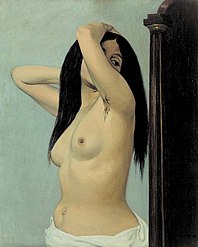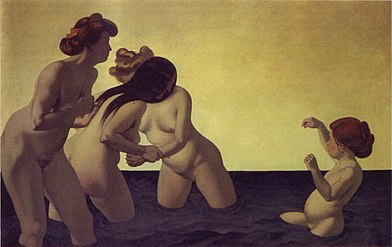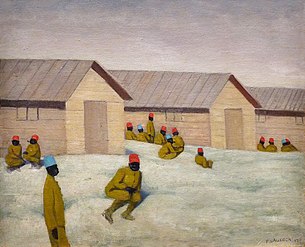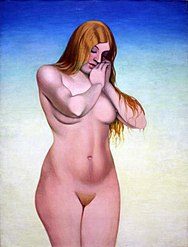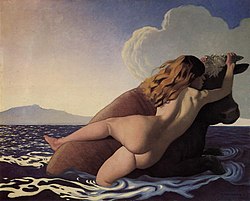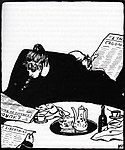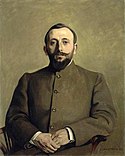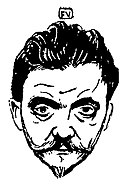Félix Vallotton
| Félix Vallotton | |
|---|---|
 Selvportræt, 1897 | |
| Personlig information | |
| Pseudonym | Vallotton, Felix |
| Født | Félix Édouard Vallotton 28. december 1865 Lausanne, Schweiz |
| Død | 29. december 1925 (60 år) Neuilly-sur-Seine, Frankrig |
| Dødsårsag | Kræft |
| Gravsted | Cimetière du Montparnasse |
| Søskende | Paul Vallotton |
| Ægtefælle | Gabrielle Bernheim (fra 1899) |
| Uddannelse og virke | |
| Uddannelsessted | Académie Julian (fra 1882) |
| Elev af | Jules Lefebvre, Gustave Boulanger |
| Medlem af | Les Nabis (1889-1903) |
| Beskæftigelse | Kunstmaler, gravør, billedhugger, xylograf, avisredaktør, grafiker, billedkunstner, forfatter, kunstkritiker, illustrator med flere |
| Fagområde | Malerkunst, skønlitteratur, billedkunst, litteratur |
| Arbejdssted | Rusland, Kongeriget Italien, Tyskland, Deauville, Honfleur, Trouville-sur-Mer, Kongeriget Nederlandene, Belgien, Genève, Zürich med flere |
| Kendte værker | Studie af balder, Bortførelsen af Europa, Alfred Athis, Den hvide og den sorte, Den syge pige med flere |
| Genre | Portræt, stilleben, landskabsmaleri, selvportræt, genremaleri med flere |
| Bevægelse | Symbolisme, Postimpressionisme, jugendstil, Impressionisme, Les Nabis |
| Påvirket af | Charles Maurin |
| Signatur | |
 | |
| Information med symbolet | |

Cimetière du Montparnasse

(Personer med tilknytning til kunsknergruppen Les Nabis)
Félix Vallotton (født 28. december 1865 i Lausanne, død 29. december 1925 i Neuilly-sur-Seine, Paris) var en schweizisk/fransk kunstmaler, der både udførte træsnit og litografier.[1] Han kom 17 år gammel til Paris og opnåede snart fransk statsborgerskab.
Vallotton har især vundet berømmelse ved sine træsnit (f.eks. af Robert Schumann i Pan[2][3]), hvor han arbejdede med store samlede flader, der kan give fremstillingen næsten karakteren af skyggebilleder.
I scener fra pariserlivet viste han sig som en udmærket iagttager; også hans plakater udmærker sig. Som maler debuterede Vallotton 1885 med et gruppebillede. Senere udstillede han interiører, landskaber og modelstudier, hvor nøgenheden fremstilledes på tværs af gængse skønhedsbegreber.
Valloton bidrog også til udstillinger med de yngste og vildeste malere; for eksempel i Musée du Luxembourg med Nøgen kvinde. Han illustrerede blandt andet Jules Renards bøger.[4]
|
|
|
Litteratur
- Julius Meier-Graefe, Félix Vallotton, Paris og Berlin 1898
Referencer
- ^ Teksten bygger især på opslaget om Félix Vallotton i Salmonsens Konversationsleksikon (2. udgave, 1928) af amtsforvalter Axel Holck i bind 24 side 466 på Runeberg.org
- ^ "Pan Volume one, Number one, April 1895". Arkiveret fra originalen 6. januar 2014. Hentet 5. januar 2014.
- ^ Félix Vallotton i Den Store Danske på lex.dk af Mikael Bøgh Rasmussen
- ^ Eksempel på hans virke som illustratør for den franske forfatter Jules Renard (fr), La Maîtresse : Jules Renard, Félix Vallotton (illustrateur) - La Maîtresse - 1896 hos Catawiki.com
- ^ De øvrige malere på billedet "Cinq peintres" fra 1902-03 er : Fra venstre mod højre, stående Félix Vallotton, siddende Pierre Bonnard, Édouard Vuillard og Charles Cottet, og stående i højre side Ker-Xavier Roussel.
- ^ Alfred Athis hos Musee-orsay.fr
Eksterne henvisninger
 Wikimedia Commons har flere filer relaterede til Félix Vallotton – Selvportrætmalerier – Litografier – Træsnit
Wikimedia Commons har flere filer relaterede til Félix Vallotton – Selvportrætmalerier – Litografier – Træsnit- Félix Vallotton på svensk satirearkiv Arkiveret 19. maj 2022 hos Wayback Machine, Satirarkivet.se
- Vallotton, Félix i Salmonsens Konversationsleksikon (2. udgave, 1928) i bind 24 side 466 af amtsforvalter Axel Holck
- Félix Vallotton i Den Store Danske på lex.dk af Mikael Bøgh Rasmussen
- "Félix Vallotton: A painter of disquiet and menace" fra Bbc.com
- Fondation Vallotton, Felixvallotton.ch (fransk)
- Fondation Vallotton fra 'Historischen Lexikons der Schweiz' (HLS) (tysk)
- Félix Vallotton fra Zeno.org
Medier brugt på denne side
La Blanche et la Noire, [The White and the Black], a 1913 painting by the Franco-Swiss painter Félix Vallotton.
"Three Women and a Little Girl Playing in the Water", 1907
Félix Vallotton - Ex-libris Frédéric Raisin
- Germany, 1893
- Alternate Title: A Schumann
- Volume, number, page: 1, no. 1 (1895-1896); following page 24
- Prints; woodcuts
- Woodcut on blue laid paper
- Image: 5 15/16 x 4 13/16 in. (15.08 x 12.22 cm)
- The Robert Gore Rifkind Center for German Expressionist Studies, purchased with funds provided by Anna Bing Arnold, Museum Associates Acquisition Fund, and deaccession funds (83.1.1350d)
- German Expressionism
The father of the family reads the anti-Dreyfusard newspaper L'Intransigeant while the young woman, with her back to him, is immersed in the Dreyfusard daily newspaper L'Aurore. We can guess, in the lower left corner, his son (?) Reading Le Libertaire, an anarchist sheet then directed by Sébastien Faure, favorable to Dreyfus. "En famille" by Félix Vallotton, woodcut published in Le Cri de Paris, February 13, 1899.
Forfatter/Opretter: Staroad.fr, Licens: CC BY-SA 4.0
Sépulture Félix Vallotton
Femme nue se regardant dans une psyché.
L'Anarchiste ("The Anarchist"), woodcut. 171 x 250 mm.
Self-portrait by Félix Valloton (1865-1925)
La charge
Den overbevisende grund
Self-portrait by Félix Vallotton
Sonnenuntergang, orangefarbener Himmel
Portrait of Alfred Athis (Natanson)
Ker-Xavier Roussel (1867-1944), Edouard Vuillard (1868-1940), Romain Coolus (1868-1952), Felix Vallotton (1865-1925), 1899.
Félix Vallotton - La tranchée 1915
La Chambre rouge
"Five painters"
Félix Vallotton autoportrait
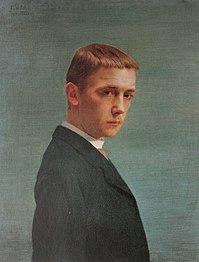



![Cinq peintres, 1902-03 (Fem malere, Vallotton stående til venstre[5])](http://upload.wikimedia.org/wikipedia/commons/thumb/1/1f/Cinq_peintres.jpg/345px-Cinq_peintres.jpg)
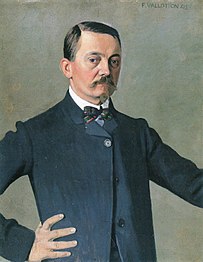




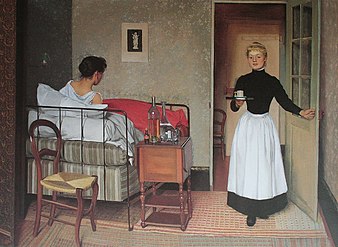
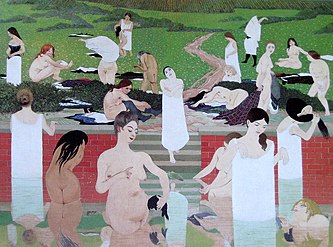
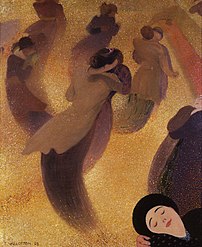

![Alfred Athis, 1906[6]](http://upload.wikimedia.org/wikipedia/commons/thumb/0/04/Felix_Vallotton_Alfred-Athis_Natanson.jpg/198px-Felix_Vallotton_Alfred-Athis_Natanson.jpg)


